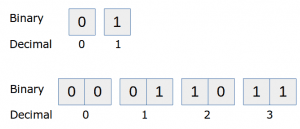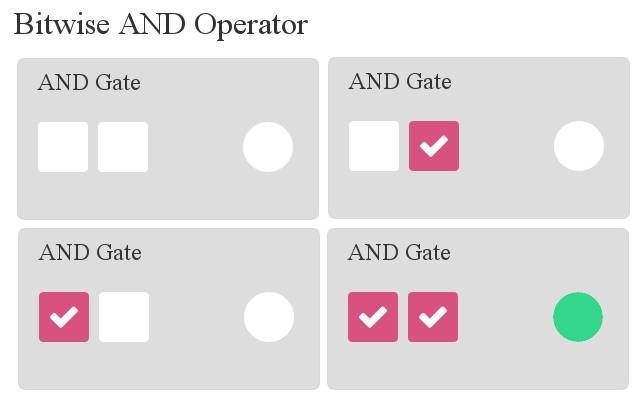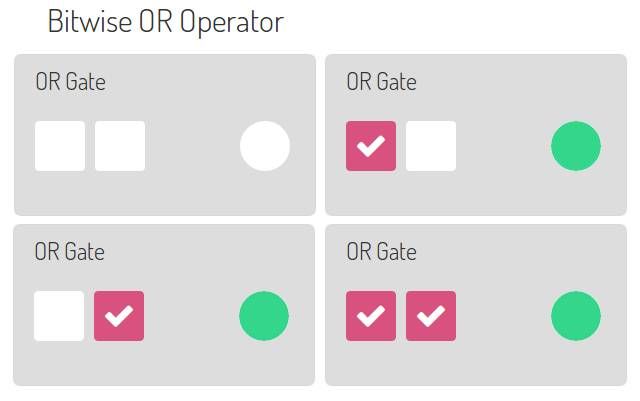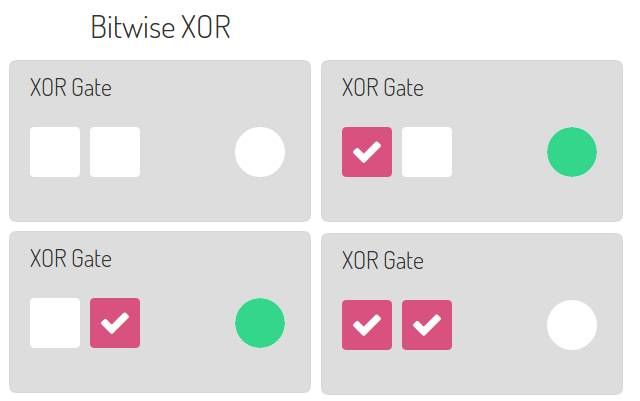python binary number
Python hosting: Host, run, and code Python in the cloud!
We have looked at simple numbers and operations before. In this article you will learn how numbers work inside the computer and a some of magic to go along with that :-)
More detailed: While this is not directly useful in web applications or most desktop applications, it is very useful to know.
In this article you will learn how to use binary numbers in Python, how to convert them to decimals and how to do bitwise operations on them.
Related course:
Python Programming Bootcamp: Go from zero to hero
Binary numbers
At the lowest level, the computer has no notion whatsoever of numbers except ‘there is a signal’ or ‘these is not a signal’. You can think of this as a light switch: Either the switch is on or it is off.
This tiny amount of information, the smallest amount of information that you can store in a computer, is known as a bit. We represent a bit as either low (0) or high (1).
To represent higher numbers than 1, the idea was born to use a sequence of bits. A sequence of eight bits could store much larger numbers, this is called a byte. A sequence consisting of ones and zeroes is known as binary. Our traditional counting system with ten digits is known as decimal.
<caption id=”attachment_824” align=”alignnone” width=”300”]
 Binary numbers and their decimal representation.
Binary numbers and their decimal representation.Lets see that in practice:
# Prints out a few binary numbers. |
The second parameter 2, tells Python we have a number based on 2 elements (1 and 0). To convert a byte (8 bits) to decimal, simple write a combination of eight bits in the first parameter.
# Prints out a few binary numbers. |
How does the computer do this? Every digit (from right to left) is multiplied by the power of two.
The number ‘00010001‘ is (1 x 2^0) + (0 x 2^1) + (0 x 2^2) + (0 x 2^3) + (1 x 2^4) + (0 x 2^5) + (0 x 2^6) + (0 x 2^7) = 16 + 1 = 17. Remember, read from right to left.
The number ‘00110010’ would be (0 x 2^0) + (1 x 2^1) + (0 x 2^2) + (0 x 2^3) + (1 x 2^4) + (1 x 2^5) + (0 x 2^6) + (0 x 2^7) = 32+16+2 = 50.
Try the sequence ‘00101010’ yourself to see if you understand and verify with a Python program.
Logical operations with binary numbers
Binary Left Shift and Binary Right Shift
Multiplication by a factor two and division by a factor of two is very easy in binary. We simply shift the bits left or right. We shift left below:
| Bit 4 | Bit 3 | Bit 2 | Bit 1 |
|---|---|---|---|
| 0 | 1 | 0 | 1 |
| 1 | 0 | 1 | 0 |
Before shifting (0,1,0,1) we have the number 5 . After shifting (1,0,1,0) we have the number 10. In python you can use the bitwise left operator (<<) to shift left and the bitwise right operator (>>) to shift right.
inputA = int('0101',2) |
Output:
Before shifting 5 0b101 |
The AND operator
Given two inputs, the computer can do several logic operations with those bits. Let’s take the AND operator. If input A and input B are positive, the output will be positive. We will demonstrate the AND operator graphically, the two left ones are input A and input B, the right circle is the output: <caption id=”attachment_843” align=”alignnone” width=”640”]
 Bitwise AND
Bitwise AND
In code this is as simple as using the & symbol, which represents the Logical AND operator.
# This code will execute a bitwise logical AND. Both inputA and inputB are bits. |
By changing the inputs you will have the same results as the image above. We can do the AND operator on a sequence:
inputA = int('00100011',2) # define binary sequence inputA |
Output:
0b100001 # equals 00100001 |
This makes sense because if you do the operation by hand:
00100011 |
The OR operator
Now that you have learned the AND operator, let’s have a look at the OR operator. Given two inputs, the output will be zero only if A and B are both zero. <caption id=”attachment_847” align=”alignnone” width=”640”]
 binary bitwise OR
binary bitwise OR
To execute it, we use the | operator. A sequence of bits can simply be executed like this:
inputA = int('00100011',2) # define binary number |
Output:
0b100011 |
The XOR operator
This is an interesting operator: The Exclusive OR or shortly XOR. <caption id=”attachment_849” align=”alignnone” width=”640”]
 bitwise XOR
bitwise XOR
To execute it, we use the ^ operator. A sequence of bits can simply be executed like this:
inputA = int('00100011',2) # define binary number |
Output:
0b100011 |

Leave a Reply:
why is this happening???
A = int('00100011',2)>>> B = int('00101101',2)
>>> print bin(A & B)
0b100001
>>> print bin(A and B)
0b101101
They are different operators, in the same way that * and + are different operators. The first one compares the bits, the second one compares both statements and should be used as if (a and b) then; In detail:
The first is a bitwise logical and. It compares the bits, if both are 1 it will be 1, otherwise 0. This means the computer simply looks if there is 'high' on both numbers at the same position.
The second is not a bitwise logical and operator and simply the normal and operator. If A and B then true.
I hope I explained well, if you have any questions feel free to ask. Hope you enjoy my site :-)
wish they made a quick and to the point tutorial for all langauges as you have done.
Agreed. These tuts are amazing. They are concise, yet packed full of vital information. This is the only tutorial series I've found that is either A) able to go into bitwise operation or B) done it well at all.
How to do a logical NOT operation using this way?
You could use the ~ operator if you want the complements. An overview of the operators is here: https://wiki.python.org/moin/BitwiseOperators
print "After shifting in binary: " + bin(inputA << 1)
Did you know the << is getting displayed in HTML code.